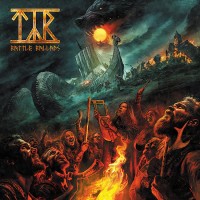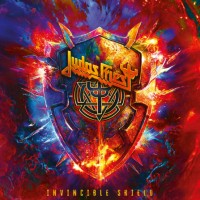Vanadium - Biography
Logo
1983-
Biography
Hailing from Milan, the five-piece Vanadium were one of Italy's first successful heavy metal bands, releasing a string of quite popular LPs throughout the early '80s before being outpaced by a quickly evolving national scene as the decade wore on. In fact, the second half of their career saw a creatively weakened Vanadium rudely subjected to both ridicule and scorn by the next generation of Italian heavy metal bands, most of whom failed to realize the older band's hokey stage banter and, at times, less than professional-sounding recordings were the result of their own country's nonexistent independent music industry infrastructure, never mind the absence of readily available peers or role models in those pre-MTV days.
The hearts of founding Vanadium members Pino Scotto di Carlo (vocals), Claudio Acquini (guitar), Ruggero Zanolini (keyboards), Domenico "Mimmo" Prantera (bass), and Lio Mascheroni (drums) were certainly in the right place when they molded their "guitar and keyboards" style of heavy metal on that of '70s heavyweights like Deep Purple and Rainbow, and named themselves after a "heavy metal" found in the periodic table of elements. The fact that vanadium is in fact a soft, ductile element, mainly used to produce certain alloys (hence the band's amusing choice of a wrench for their emblem) obviously escaped them, and was later used by critics as evidence of their terminal haplessness -- but Vanadium's 1982 debut, Metal Rock, though uneven and rough-hewn, was a respectable first try by the day's (and their country's) modest standards. It was quickly followed and overshadowed by far more accomplished and confident efforts like 1983's A Race with the Devil and 1984's Game Over, both of which showed off the musicians' undeniable technical chops, benefited from hotshot new guitar find Steve Tessarin (born Stefano Tessarin), and reportedly sold as much as 50,000 copies each -- again, a huge sum by period standards.
Vanadium's sales still relied predominantly on grassroots tape-trading and fan word of mouth, as Italy's heavily government-regulated media provided little support for heavy metal and a disorganized touring circuit offered few and sporadic opportunities for the band to perform live. Their 1985 "live" album, On Streets of Danger, reveals as much, framing the band's biggest hits thus far over hilariously fake-sounding -- probably studio-patched -- audience noises. Nevertheless, it too sold in healthy quantities to domestic fans, and it was only with their longtime indie label Durium's collapse into bankruptcy, and the delivery of increasingly less inspired follow-ups like Born to Fight (1986), Corruption of Innocence (1987), and Seventh Heaven, that Vanadium found themselves suddenly out of favor with younger heavy metal fans.
By then, those fans had finally been exposed to major international superstars as heavy metal's worldwide popularity escalated by leaps and bounds and an entirely new crop of young local bands (Bulldozer, Extrema, etc.) were making light of Vanadium's increasingly dated albums, ready to take their place. Vanadium quietly acquiesced, and Scotto's first solo album, IIl Grido Disperato di Mille Band (The Desperate Cry of a Thousand Bands), essentially served notice of their breakup. The singer would eventually reconvene Vanadium for 1995's Nel Cuore del Caos (In the Heart of Chaos), but public indifference saw them folding yet again, only to strangely re-emerge in 2003, under the new moniker Fire Trails, and record a Vanadium Tribute album. ~ Eduardo Rivadavia, All Music Guide
(source: http://music.aol.com/artist/vanadium/biography/1165318)
The hearts of founding Vanadium members Pino Scotto di Carlo (vocals), Claudio Acquini (guitar), Ruggero Zanolini (keyboards), Domenico "Mimmo" Prantera (bass), and Lio Mascheroni (drums) were certainly in the right place when they molded their "guitar and keyboards" style of heavy metal on that of '70s heavyweights like Deep Purple and Rainbow, and named themselves after a "heavy metal" found in the periodic table of elements. The fact that vanadium is in fact a soft, ductile element, mainly used to produce certain alloys (hence the band's amusing choice of a wrench for their emblem) obviously escaped them, and was later used by critics as evidence of their terminal haplessness -- but Vanadium's 1982 debut, Metal Rock, though uneven and rough-hewn, was a respectable first try by the day's (and their country's) modest standards. It was quickly followed and overshadowed by far more accomplished and confident efforts like 1983's A Race with the Devil and 1984's Game Over, both of which showed off the musicians' undeniable technical chops, benefited from hotshot new guitar find Steve Tessarin (born Stefano Tessarin), and reportedly sold as much as 50,000 copies each -- again, a huge sum by period standards.
Vanadium's sales still relied predominantly on grassroots tape-trading and fan word of mouth, as Italy's heavily government-regulated media provided little support for heavy metal and a disorganized touring circuit offered few and sporadic opportunities for the band to perform live. Their 1985 "live" album, On Streets of Danger, reveals as much, framing the band's biggest hits thus far over hilariously fake-sounding -- probably studio-patched -- audience noises. Nevertheless, it too sold in healthy quantities to domestic fans, and it was only with their longtime indie label Durium's collapse into bankruptcy, and the delivery of increasingly less inspired follow-ups like Born to Fight (1986), Corruption of Innocence (1987), and Seventh Heaven, that Vanadium found themselves suddenly out of favor with younger heavy metal fans.
By then, those fans had finally been exposed to major international superstars as heavy metal's worldwide popularity escalated by leaps and bounds and an entirely new crop of young local bands (Bulldozer, Extrema, etc.) were making light of Vanadium's increasingly dated albums, ready to take their place. Vanadium quietly acquiesced, and Scotto's first solo album, IIl Grido Disperato di Mille Band (The Desperate Cry of a Thousand Bands), essentially served notice of their breakup. The singer would eventually reconvene Vanadium for 1995's Nel Cuore del Caos (In the Heart of Chaos), but public indifference saw them folding yet again, only to strangely re-emerge in 2003, under the new moniker Fire Trails, and record a Vanadium Tribute album. ~ Eduardo Rivadavia, All Music Guide
(source: http://music.aol.com/artist/vanadium/biography/1165318)




